Chapter: Physics : Super Conducting Materials
Super Conducting Materials
SUPER CONDUCTING MATERIALS
1
Introduction
2
Super conducting phenomena
2.1
General Features
3
Properties of Superconductor
4
Types of superconductors
4.1
Type-I superconductor
4.2
Type-II superconductor
5
Difference between Type I & Type-II superconductors
6
BCS theory of superconductivity
7
High Tc Superconductivity
7.1
Properties of high Tc superconductors
7.2
Preparation and crystal structure of high Tc ceramic superconductor (YBa2 Cu3 O9.X)
8
Application of superconducting materials engineering applications
8.1
Electric Generator
8.2
Low Loss transmission & Transformer
8.3
Cryotron
8.4
Josephson Devices
8.5
SQUID
8.6
Magnetic Levitated Train
8.7
Engineering Applications
8.8
Medical Applications
1. INTRODUCTION
Super conductivity is one of the most existing
phenomena in physics. It was discovered by Dutch physicist H.K Onnes in the
year 1905.
Before the discovery of super conductivity, it was
though that the electrical resistance is zero only at absolute zero. But, it
was found that in some material the electrical resistance becomes zero, when
they are cooled to very low temperature.
2 SUPERCONDUCTING PHENOMENA
Super conducting materials have extraordinary
electrical and magnetic characteristics. These materials have many important
applications in the field of engineering and technology. Many electronic and
magnetic devices have been fabricated with super conducting materials.
Definition
The phenomenon of sudden disappearance of electrical
resistance in a material, when it is cooled blow a certain temperature is known
as super conductivity.
Transition temperature or critical
temperature:
The temperature at which a material at normal
conducting state changes into superconducting state is known as transition
temperature or critical temperature (Tc).
The transition
temperature depends on the property of the material. It is found that the super
conducting transition is reversible, i.e, above critical temperature (Tc) a
super conductor becomes a normal conductor.
It is to note that the
metals which are normally very good conductors of heat and electricity (e.g.
Cu. Ag, Au) are not super conductors.
2.1GENERAL FEATURES
1. Superconductivity
is found to occur in metallic elements in which the number of valence electron
lies between 2 and 4.
2. Materials
having high normal resistivities exhibit superconductivity.
3. Superconductivity
is also favoured by small atomic volume accompanied by a small atomic mass.
4. The
transition temperature(Tc) is different for different substances.
5. Ferromagnetic
and antiferromagnetic materials are not superconductors.
6. The
electrical resistivity drops to zero.
7. The
magnetic flux lines are expelled from the material.
8. There
is a discontinuous change in the specific heat.
9. Further,
there is some small changes in the thermal conductivity and the volume of the
materials.
3 PROPERTIES OF SUPER
CONDUCTORS
Zero electrical resistance
The first characteristic property of a
super conductor is its electrical resistance. The electrical resistance of the
super conductor is zero below a transition temperature. This property of zero
electrical resistance is known as defining property of a superconductor.
The variation of electrical resistivity of a normal
conducting metal and a superconducting metal as a function of temperature is
shown in fig
Effect of magnetic field
Below the transition temperature of a
material, its superconductivity can be destroyed by the application of a strong
magnetic field.
The
minimum magnetic field strength required to destroy the superconducting
property at any temperature is known as critical magnetic field (Hc).
The critical magnetic field (Hc) depends
upon the temperature of the superconducting material. The relation between
critical magnetic field and temperature is given by
Hc = Ho [1- (T / Tc)2]
Where,
Ho- is critical magnetic field at absolute zero temperature.
Tc-
is superconducting transition temperature of a material
T
–is the temperature below Tc of the superconducting material.
Effect electric current
The application of very high electrical
current to superconducting material destroys its superconducting property.
The critical current ic
required to destroy the superconducting property is given by Ic =
2πrHc
Where
Hc –is the critical magnetic field
r
- is the radius of the superconducting wire
Persistent current
A steady current which flows through a
superconducting ring without any decrease in its strength as long as the
material is in superconducting state is called persistent current. The current
persists even after the removal of the magnetic field.
Meissner effect
When a superconducting material is p the
magnetic lines of force penetrates through the material as shown in fig.
Now, when the material is cooled below
its transition temperature then the magnetic lines of force are ejected out
from the material as shown in fig.
We know that diamagnetic material have the tendency
to expel the magnetic lines of force. Since the super conductor also expels the
magnetic lines of forces it behaves as a perfect diamagnet. This behaviour is
first observed by Meissner and hence called as Meissner effect.
When a superconducting material is placed in a
magnetic field, under the condition T≤Tc and H≤Hc the flux lines are excluded
diamagnetism. This phenomenon is called as Meissner effect.
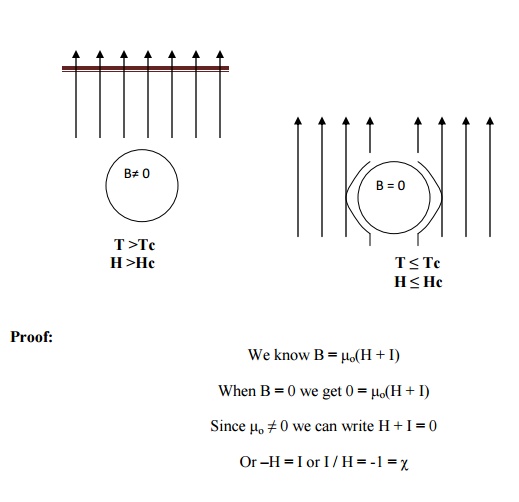
Since
the susceptibility is negative, this shows that superconductor is perfect
diamagnet.
Isotope
effect
The transition temperature varies due to
presence of isotopes.
Example:
The atomic mass of mercury varies from
199.5 to 203.4, and hence the transition temperature varies from 4.185 K to
4.146 K.
Due to
the relationship Tc α [1 / Mα]
M –atomic weight
α- constant (=.5)
4. TYPE-I AND TYPE-II SUPERCONDUCTORS
There are two types of super conductors
based on their variation in magnetization, due to external magnetic field
applied.
Type I
superconductor or soft super conductor
Type II
superconductor or hard superconductor
4.1. TYPE I SUPERCONDUCTOR
When the super conductor is kept in the magnetic field and if the field is increased
the superconductor becomes normal conductor abruptly at critical
magnetic field as shown in fig. These types of materials are termed as Type I
superconductors.
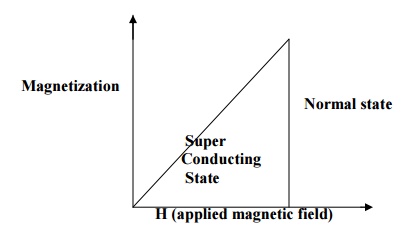
Below critical field, the specimen
excludes all the magnetic lines of force and exhibit perfect Meissner effect.
Hence, Type I superconductors are perfect diamagnet, represented by negative
sign in magnetization.
4.2.TYPE
II SUPERCONDUCTORS
When the super conductor kept in the magnetic field
and if the field is increased, below the lower critical field Hc1, the material
exhibit perfect diamagnetism (i.e) it behaves as a super conductor and above
Hc1, the magnetization decreases and hence the magnetic flux starts penetrating
through the material. The specimen is said to be in a mixed state between Hc1
and Hc2. above Hc2 (upper critical field) it becomes normal
conductor as shown in fig.
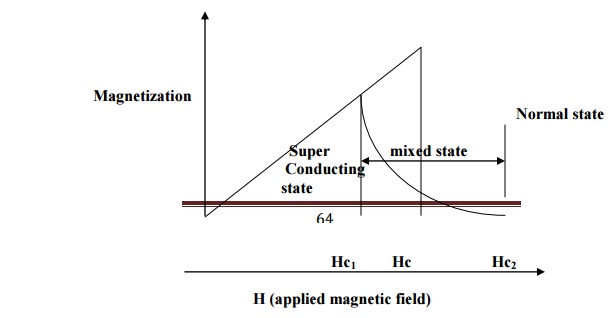
The materials which
lose its superconducting property gradually due to increase on the magnetic
field are called Type II superconductor.
5 DIFFERENCE BETWEEN TYPE –I AND TYPE
–II SUPERCONDUCTORS
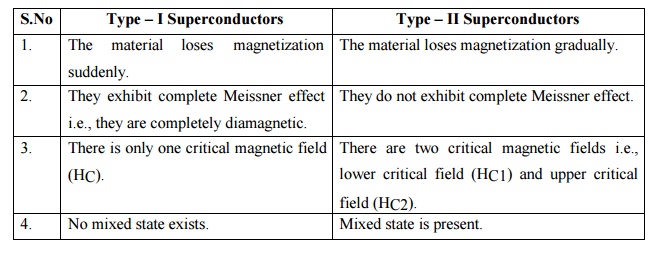
S.No Type
–I Superconductors
1. The material loses
magnetization suddenly.
2. They exhibit complete Meissner effect i.e., they are
completely diamagnetic.
3. There is only one critical magnetic field (HC).
4. No mixed state exists.
Type
–II Superconductors
The material loses magnetization gradually.
They do not exhibit complete Meissner effect.
There are two
critical magnetic fields
i.e., lower critical field (HC1) and upper critical field (HC2).
Mixed state is present.
6 BCS THEORY
BCS
theory (qualitative):
The microscopic theory
of superconductivity developed by J. Bardeen, L.N. Cooper and J.R. Scriffer in
1957, successfully explained the effect like zero resistivity, Meissner effect
etc. this theory is known as BCS theory.
Principle
This theory states that
the electrons experience a special kind of attractive interaction, overcoming
the coulomb forces of repulsion between them; as a result cooper pairs (i.e)
electro pair are formed. At low temperature, these pairs move without any
restriction through the lattice points and the material becomes superconductor.
Here the electron-lattice-electrons interaction should be stronger than
electrons-electros interaction.
Important features of BCS theory:
Electrons form pairs (called cooper pair) which
propagate throughout the lattice.
The propagation of cooper pairs is without
resistance because the electrons move in resonance with phonons.
Electron-lattice-electron interaction
When an electron (1st)
moves through the lattice, it will be attracted by the core (+ve charge) of the
lattice. Due to this attraction, ion core is disturbed and it is called as
lattice distortion. The lattice vibrations are quantized in terms of phonons.
The deformation
produces a region of increased positive charge. Thus if another electron (2nd)
moves through this region as shown in fig. it will be attracted by the greater
concentration of positive charge and hence the energy of the 2nd
electron is lowered.
Hence two electrons
interact through the lattice or the phonons field resulting in lowering the
energy of electrons. This lowering of energy implies that the force between the
two electrons is attractive. This type of interaction is called electrons-lattice
electron interaction. The interaction is strong only when the two electrons
have equal and opposite momenta and spins.
Explanation
Consider the 1st
electron with wave vector k distorts the lattice, here by emitting phonons of
wave vector q. This results in the wave vector k-q for the 1st
electron. now if the 2nd electron with wave
vector k’, seeks the
lattice it takes up the shown in fig. two electrons with wave vectors k-q and
k’+qknownformascooperpair.pair
Cooper
pair
The pair of electrons
formed due to electron-lattice (phonons)-electron interaction (force of
attraction) by overcoming the electron-electron interaction (force of
repulsion), with equal and opposite momentum and spins (i.e) with wave vector
k-q and k’+q, are called coo
Coherence
length
In the
electron-lattice-electron interaction, the electrons will not be fixed, they
move in opposite directions and their co-relations may persist over lengths of
maximum 10-6m. This length is called coherence length.
Note: BCS theory hold
good only for low temperature superconductivity.
7. HIGH TEMPERATURE SUPERCONDUCTOR
In a superconductor if
the transition temperature is high ie., greater than 20K, then it is called as
high temperature superconductor.
Earlier it was believed
that the superconductivity was only in metals. Surprisingly in 1986, Muller and
Bednorz discovered high temperature superconductor in ceramics.
They made a particular
type of ceramic material from a compound of barium, lanthanum, copper and
oxygen (Ba-La-Cu-O). This compound superconductor showed superconductivity even
at a temperature as high as 30K.
The oxide Y Ba2
Cu3 O7 with a Tc of 90K was the most extensively studied
high temperature superconductor.
7.1. CHARACTERISTICS OF HIGH TEMPERATURE
SUPERCONDUCTOR
They have high transition temperature.
They have a modified perovskite crystal structure.
Formation of the superconducting state is direction
dependent.
They are oxides of copper in combination with other
elements.
They are reactive, brittle, and cannot be easily
modified or joined.
7.2. PREPARATION OF HIGH TC CERAMIC
SUPERCONDUCTOR Y BA2 CU3 O9-X
The oxide (Y Ba2
Cu3 O9-x) is prepared from compacted powder mixture of Y2O3,
BaCO3 and CuO in the right proportion and heating them in
temperature between 900°C and 1100°C. BaCO3 decomposes at this
temperature to BaO and CO2. This is followed by another annealing
treatment at 800°C in an atmosphere of oxygen.
Crystal structure of Y Ba2 Cu3
O9-x
Here, the primitive cell is developed by three body
centered cubic unit cells stacked one above the the other to form a tetragonal
(a=b≠c) perovskite structure tripled along the C axis.
Yttrium atoms:
Each yttrium atom is shared by one unit cell.
1 / 1th of the atom is shared by that
unit cell.
Number of yttrium atoms per unit cell = 1 / 1 X
total number of yttrium atoms
=
1 / 1 X 1 = 1
Barium
atoms
Each barium atom is one unit cell
1 / 1th of the atom is shared by that
unit cell.
Number barium atoms per unit cell = 1 / 1 X total
number of yttrium atoms
=
1 / 1 X 2 = 2 atoms per unit cell.
Copper atoms
Each yttrium atom is shared by 8 unit cells [since
copper is the corner atoms].
1 / 8 th of the atom is shared by one
unit cell.
Number copper atoms per unit cell = 1 / 8 X total
number of yttrium atoms
X
number of unit cells
=
1 / 8 X 8 X 3 =3 atoms per unit cell.
Oxygen
atoms
Each yttrium atom is
shared by 4unit cells [since oxygen atoms are situated at mid points between
two corner atoms].
1 / 4th of the atom is shared by one unit
cell.
Number copper atoms per unit cell = 1 / 4 X total
number of yttrium atoms
X
number of unit cells
= 1
/ 4 X 12 X 3 =9 atoms per unit cell.
8 APPLICATION OF
SUPERCONDUCTORS:
8.1.ELECTRIC GENERATORS
Superconducting
generators are very small in size and light weight when compared with
conventional generators. The low loss superconducting coil is rotated in
extremely strong magnetic field. Motors with very high powers as large as 2500
kw could be constructed at very low as 450 V. This is the basis of new
generation of energy saving power systems.
8.2 LOW LOSS TRANSMISSION LINE AND
TRANSFORMERS
Since, the resistance is almost zero at
superconducting phase, the power loss during transmission is negligible. Hence,
electric cables are designed with superconducting wires. If superconductors are
used for winding the transformers, the power loss will be very small. Using
superconductor, 2000-3000 MW portable transformers have been manufactured.
8.3. CRYOTRON
Cryotron
is a magnetically operated current switch.
Principle
We know that the superconducting property of a
material disappears when the applied magnetic field is greater than the
critical magnetic field.
Consider a superconducting material A surrounded by
another superconducting material B as shown in fig. let the critical magnetic
field of material A be less than the critical magnetic field of material B.
Initially, let the temperature of the whole system blow the transition
temperature of two materials.
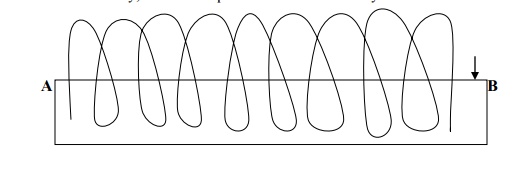
Now at the operating temperature, the magnetic field
produced by material B may exceed the critical
magnetic field of material A. Hence, material A
becomes a normal conductor because the critical magnetic field of A is less
than that of B.
Moreover, B not become
a normal conductor at the critical magnetic field of A because HcB
> HcA. Therefore the current in the material A can be controlled
by the current in the material B. hence this system can act as a relay or
switching element.
8.4. JOSEPHSON DEVICES Principle
A steady and undiminishing current
(Persistent of current) influenced by d.c. voltage is the principle used in
Josephson devices.
Josephson Effect
Josephson effect happens by virtue of
quantum tunnelling of Cooper pairs. According to Josephson effect, the
tunnelling cooper pairs would take place between two superconductors separated
by an insulator even in the absence of applied voltage. Pairs of electrons move
through the potential barrier induce the superconducting current. This effect
is know as Josephson effect.
Explanation
It consists of a thin layer of oxide
material placed in between tow supeconducting materials as shown in. Here, the
Oxide layer acts as a barrier to the flow of conduction electrons from one
superconductor to the other.
When the battery is switched ON, the voltage V is
applied across the super conductors. Due to applied voltage, the electrons in
the super conductor –1 is tunnel across the insulator into the super conductor
–2. This tunneling effect produce the current between the superconductors. The
increase in voltage produce more and more electrons and hence increases the
current. This current has two components.
8.5. SQUID:
QUID stands for
Superconducting Quantum Interference
Device. It is
an ultra-sensitive instrument
used to measure very weak magnetic field in the order of 10-14 tesla.
Principle
We know that small change in magnetic field produces
in the flux quantum
Description and working
A SQUID consist of superconducting wire which can
have the magnetic field of quantum values (1, 2, 3…) of flux placed in between
two Josephson junctions as shown in fig.
Then magnetic field if applied perpendicular to the
plane of the ring, the current is produced at the two Josephson junctions. The
induced current produces the interference
pattern and it flows through the ring so that the magnetic
flux in the ring can have the quantum value of magnetic field applied.
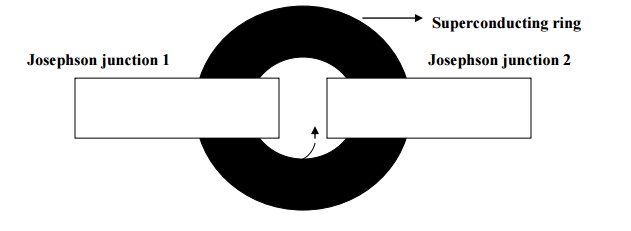
Application
It can be used to detect the variation of very
minute magnetic signals in terms of quantum flux. It can also be used as
storage device for magnetic flux.
It is useful in the study of earthquakes, removing
paramagnetic impurities, detection of magnetic signals from the brain, heart.
8.6. Magnetic levitated train (MAG LEV)
Magnetic levitated
train is the train which cannot move over the rail, rather it floats above the
rail, under the condition, when it moves faster.
Principle
Electromagnetic induction is used as the principle.
(i.e) when there is a relative motion of a conductor across the magnetic field,
current is induced in the conductor and vice versa.
Direction of magnetic force
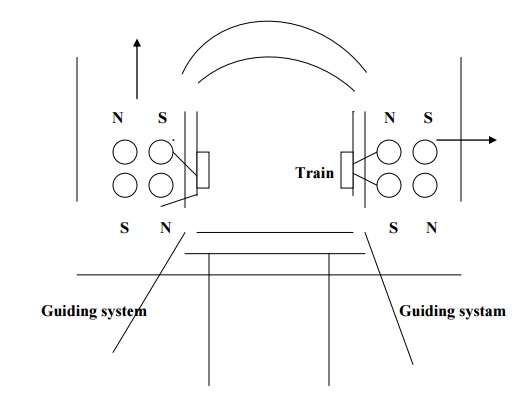
Explanation
This train consists of superconducting magnets
placed on each side of the train. The train can run in a guidance system which
consists of a series of 8 shaped coils as shown in fig.
Initially when the train starts, they slide on the
rails. Now, when the train moves faster, the superconducting magnets on each
side of th kept in the guidance system.
This induced current generates a magnetic force in
the coils in such a way that the lower half of the 8-shaped coil has the same
magnetic pole as that of the superconducting magnet in the train, while the
upper half has the opposite magnetic pole.
Therefore the total upward magnetic force acts on
the train and hence the train is levitated (or) raised above the wheels (i.e)
the train now floats above the air.
Now, by alternatively changing the poles of the
superconducting magnet in the train alternating current can be induced in the
“8” shaped c
Thus, alternating series of north and south magnetic
poles are produced in the coils which pulls and pushes the superconducting magnets
in the train and hence the train is further moved.
The magnetic levitated train can travel a speed 500
km/hour, which is double the speed of existing fastest train
Note: The train is
supposed to move always at the centre. Suppose if it moves away from the
centre, say for example right side, an attractive force is given at the left
side, and a repulsive force is given at the right side and is made to come at
the centre.
8.7. ENGINEERING APPLICATIONS
1.
They are used to construct very
sensitive electrical measuring instruments such as galvanometers because they
requires very small voltages.
2.
They are used to transmit power over
very long distance without any power loss.
3.
They are used as storae devices in
computers.
4.
Superconductors are used to design
rectifiers, logic gates, modulators etc.
8.8. MEDICAL APPLICATIONS
1. They
are used to study tiny magnetic signals from brain and heart.
2. They
are used in NMR imaging systems.
3. They
are used to detect brain tumours and clots using superconductingsolenoids.
4. They
are used in magneto-cardiography, magneto –encephalography.
5. They are used to study the amount of iron held in the lever of the body accurately.
Related Topics